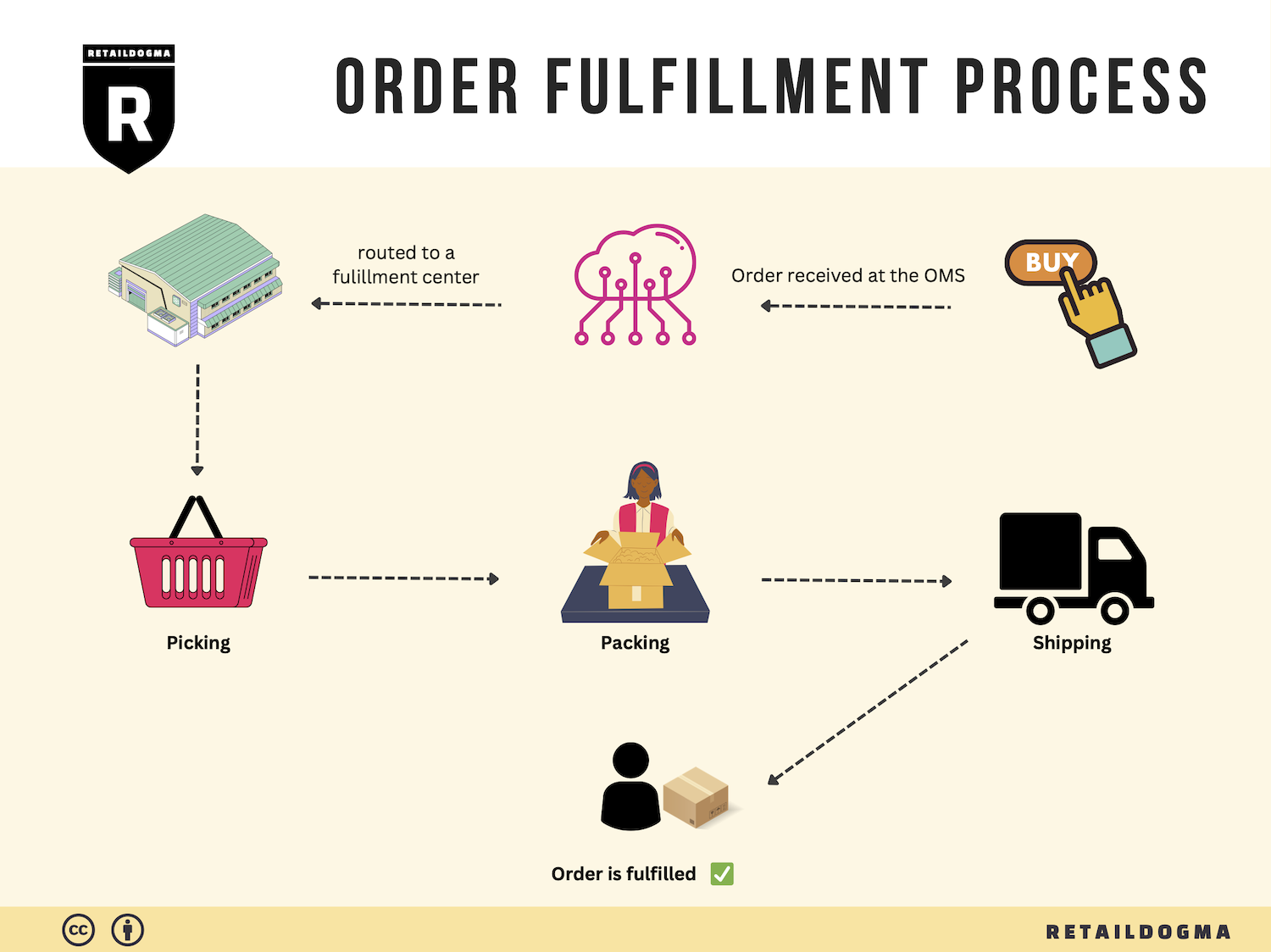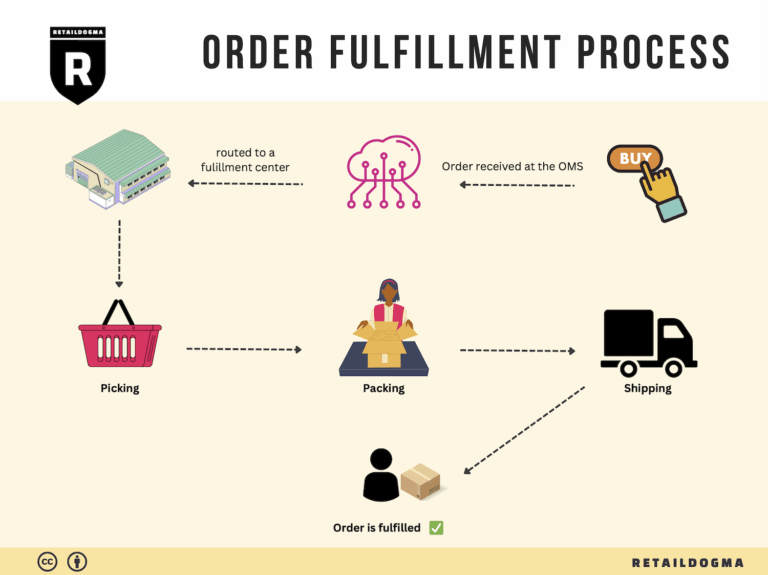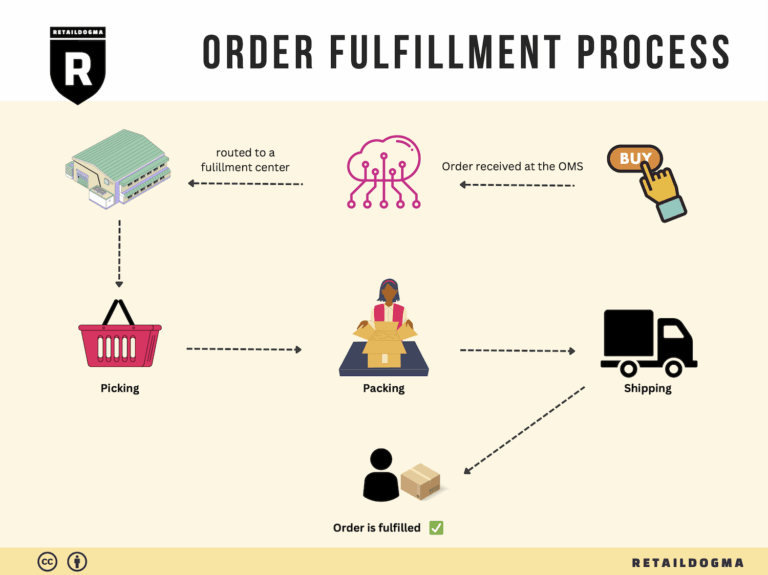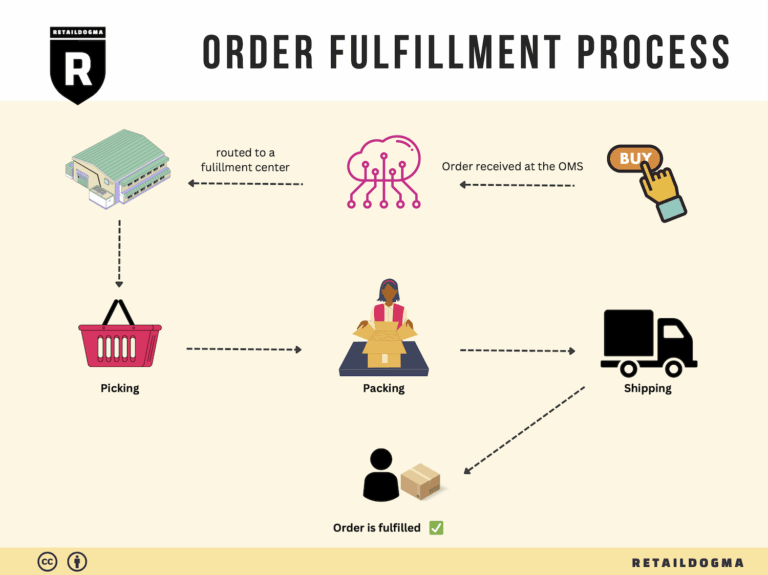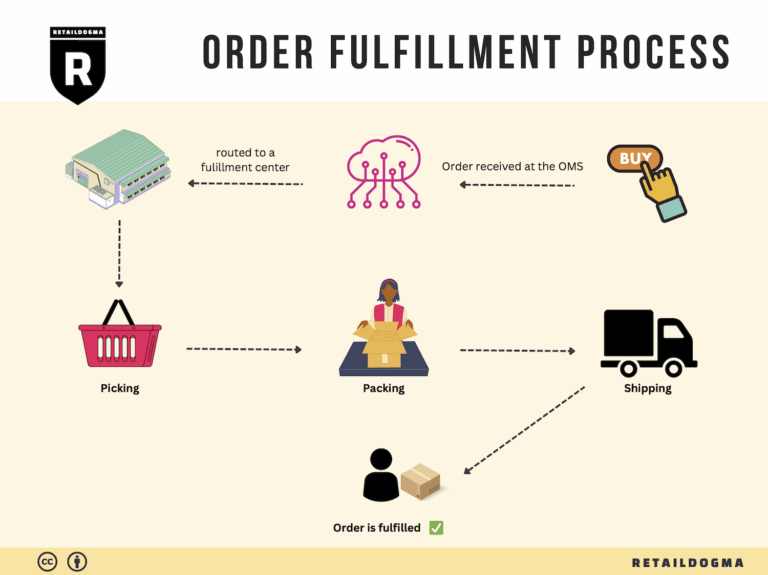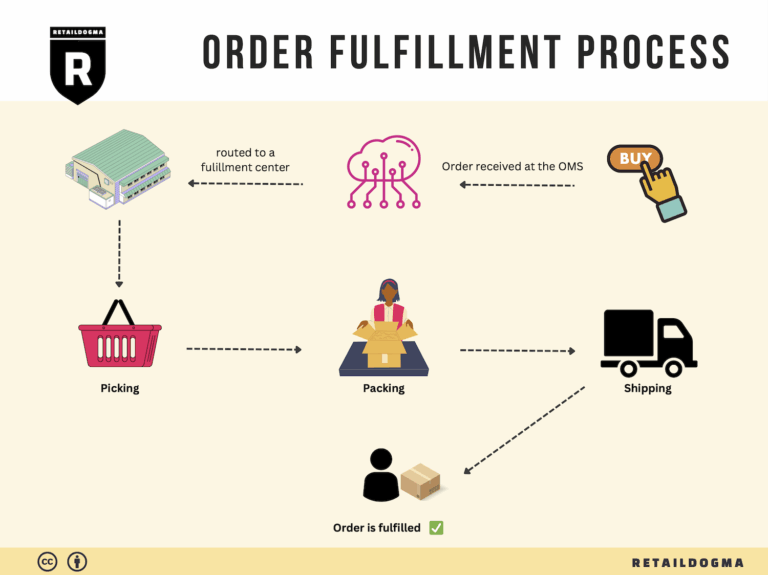How Order Fulfillment Works: A Step-by-Step Guide for Businesses
What is E-commerce Fulfillment? An Introduction for Growing Businesses
Understanding E-commerce Fulfillment: A Key to Scaling Your Business
As a growing e-commerce business, you may find yourself grappling with the complexities of packing and shipping orders. The excitement of expanding your customer base can quickly turn into stress when faced with logistical challenges. Managing order fulfillment—essentially the process of getting a product from your warehouse to your customer’s doorstep—can become overwhelming. This is where a solid understanding of e-commerce fulfillment can make a significant difference.
E-commerce fulfillment encompasses a range of activities that include inventory management, order processing, packing, and shipping. For many businesses, the fulfillment process can be the backbone of customer satisfaction; timely delivery and accurate order fulfillment are critical for retaining customers and fostering brand loyalty. However, as order volumes increase, so does the complexity of fulfillment. This guide aims to demystify the fulfillment process and provide you with practical insights to help you scale your operations effectively.
We will explore various fulfillment models, including Third-Party Logistics (3PL) and Fulfillment by Amazon (FBA). Understanding these models will enable you to choose the right approach that aligns with your business needs. Each option has its own set of advantages and disadvantages, and knowing the nuances can help you make informed decisions.
Moreover, we will delve into the core services that fulfillment providers offer. This includes inventory storage, order picking and packing, shipping logistics, and returns management. By understanding what these services entail, you can better evaluate potential partners and their capabilities.
Choosing the right fulfillment partner is crucial for your business’s success. We will provide guidelines on how to assess potential partners based on factors such as scalability, technology integration, customer service, and geographical reach.
Finally, we will discuss pricing structures and what to expect in terms of costs associated with various fulfillment services. Understanding these costs will help you budget effectively and avoid unexpected expenses as you grow.
The ultimate goal of this guide is to empower you with the knowledge to make smart logistics decisions that will enhance your operational efficiency and customer satisfaction. With the right strategies in place, you can turn fulfillment challenges into opportunities for growth.
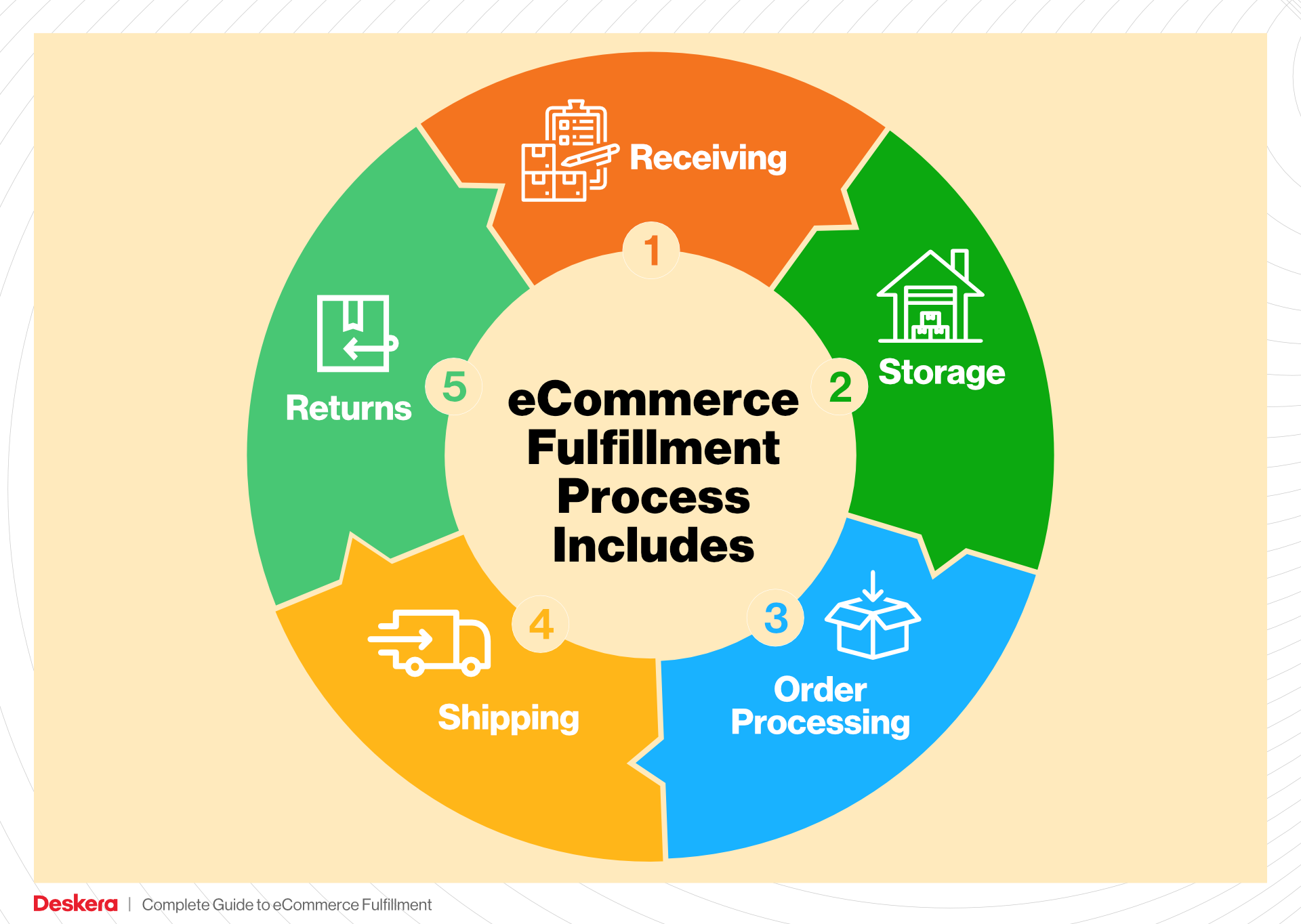
What You’ll Learn In This Guide
- What is E-commerce Fulfillment? An Introduction for Growing Businesses
- The Order Fulfillment Process: From ‘Buy’ Button to Customer’s Door
- Comparing Fulfillment Models: In-House vs. 3PL vs. Dropshipping
- A Deep Dive into Amazon FBA: Pros, Cons, and Who It’s For
- Core Services Offered by Fulfillment Centers
- How to Choose a Fulfillment Partner: A 6-Point Checklist
- Understanding Fulfillment Pricing: A Breakdown of Common Fees
- Frequently Asked Questions (FAQs) about Fulfillment
- Conclusion: Is Outsourcing Fulfillment the Right Move for Your Business?
- Important Disclaimer
The Order Fulfillment Process: From ‘Buy’ Button to Customer’s Door
1. Receiving Inventory
The first step in the order fulfillment process is receiving inventory into your warehouse or fulfillment center. This involves accepting shipments from suppliers and ensuring that the products match the purchase orders in terms of quantity, quality, and specifications. Key activities in this step include unloading goods, inspecting for damages, and updating inventory records.
This step is crucial because accurate inventory counts are the foundation of effective order fulfillment. Discrepancies can lead to stockouts or overstock situations, both of which can harm customer satisfaction and financial performance. A critical term associated with this process is SKU (Stock Keeping Unit). Each product should have a unique SKU, enabling easy tracking and management within your inventory system.
2. Warehouse Storage
Once inventory is received, the next step is warehouse storage. Products are organized and stored in designated locations within the warehouse. This may involve shelving, pallet racking, or specialized storage systems depending on the type of products being stored. Efficient storage solutions not only maximize space but also facilitate quick access to items when orders come in.
The importance of this step lies in optimizing the layout and organization of your warehouse. A well-organized warehouse reduces the time spent searching for items, which can significantly enhance operational efficiency. A key concept here is ABC Analysis, a method used to categorize inventory based on importance and turnover rates, allowing you to prioritize high-demand items for easier access.
3. Order Picking
Order picking is the process of selecting items from storage to fulfill customer orders. This step can be carried out in various ways, including single order picking, batch picking, or wave picking, depending on the volume and complexity of orders. Workers use a pick list—a document that outlines the items and quantities needed for each order—to guide their picking process.
The efficiency of order picking directly impacts order fulfillment speed and accuracy. Delays or errors in this step can lead to customer dissatisfaction and increased return rates. Implementing technologies like barcode scanning or pick-to-light systems can enhance accuracy and speed in this phase, ensuring that the right products reach customers in a timely manner.
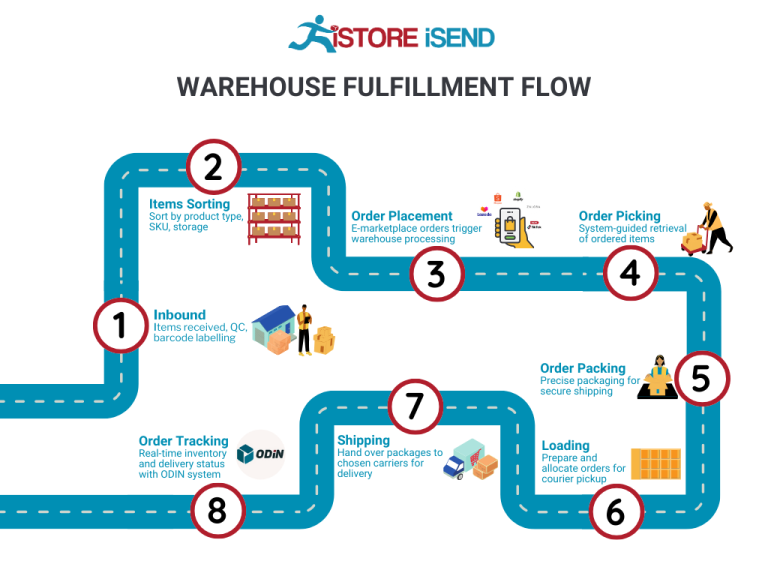
4. Order Packing
After items are picked, they are moved to the packing area, where they are prepared for shipment. This step involves verifying the items against the order, choosing appropriate packaging materials, and labeling the packages for delivery. Effective packing not only protects products during transit but also enhances the customer experience through thoughtful presentation.
The significance of packing lies in its dual role of ensuring product safety and reinforcing brand identity. A well-packed order can leave a lasting impression on customers, encouraging repeat purchases. A relevant term here is dimensional weight pricing, which considers package dimensions in shipping costs, underscoring the importance of efficient packing to minimize shipping expenses.
5. Shipping & Delivery
The final step in the order fulfillment process is shipping and delivery. Once packages are packed and labeled, they are handed over to carriers for transportation to the customer’s address. This stage includes selecting the right shipping method based on cost, speed, and destination, as well as tracking shipments to keep customers informed.
This step is vital as it directly affects delivery times and customer satisfaction. Efficient shipping processes can lead to faster deliveries, which are increasingly expected in today’s e-commerce landscape. A key term associated with this process is last-mile delivery, which refers to the final leg of the shipping journey where the package reaches the customer’s door. Optimizing this stage can help reduce costs and improve service levels, making it a critical focus for businesses looking to scale effectively.
By understanding and optimizing each of these five steps in the order fulfillment process, e-commerce businesses can improve operational efficiency, enhance customer satisfaction, and ultimately drive growth in their logistics and sales operations.
Comparing Fulfillment Models: In-House vs. 3PL vs. Dropshipping
Fulfillment Model Comparison
| Model | Who Handles Inventory | Best For (Business Stage) | Key Advantage | Key Disadvantage |
|---|---|---|---|---|
| In-House Fulfillment | Business itself | Established businesses with stable sales | Complete control over inventory and processes | High overhead costs and resource-intensive |
| Third-Party Logistics (3PL) | Outsourced to a logistics provider | Scaling businesses seeking efficiency | Cost-effective and scalable with expertise | Less control over inventory and potential hidden fees |
| Dropshipping | Supplier/vendor | Startups or businesses with low capital | Minimal upfront investment and low risk | Lower profit margins and longer shipping times |
In-House Fulfillment
In-house fulfillment involves managing the entire logistics process within your organization. This model is typically favored by established businesses that have stable sales and can afford the overhead costs associated with maintaining a warehouse and a logistics team. Companies using in-house fulfillment have complete control over their inventory, allowing them to manage stock levels, quality assurance, and order processing directly. This can lead to faster shipping times and a more personalized customer experience since businesses can tailor their fulfillment processes to meet specific customer needs.
However, the in-house model comes with significant disadvantages. The costs of warehousing, labor, and technology can accumulate quickly, making it resource-intensive, particularly for smaller businesses or those experiencing fluctuations in sales. Additionally, maintaining an in-house operation requires substantial management oversight, which can detract from focusing on core business activities like marketing and product development. Therefore, while in-house fulfillment can provide control and efficiency, it may not be the best fit for all business stages, particularly startups or those looking to scale rapidly.
Third-Party Logistics (3PL)
Third-party logistics (3PL) providers offer businesses the ability to outsource their fulfillment operations to specialized logistics companies. This model is particularly advantageous for businesses that are scaling and need to improve efficiency without the overhead costs of managing their own warehouse and logistics. 3PL providers handle inventory management, warehousing, order fulfillment, and shipping, allowing businesses to focus on their core competencies such as product development and customer service.
One of the primary benefits of using a 3PL is cost-effectiveness. These providers often have established shipping contracts and logistics networks, which can lead to lower shipping rates and improved delivery times. Furthermore, 3PLs bring industry expertise, helping businesses navigate complex logistics challenges, especially in a dynamic market like Jacksonville, where factors such as port access and regional regulations can impact fulfillment strategies.
However, outsourcing fulfillment can also introduce challenges. Businesses may find they have less control over inventory management, which can affect order accuracy and customer satisfaction. Additionally, 3PL services often come with fees that can vary based on the services used, potentially leading to unexpected costs. For businesses that prioritize flexibility and control, carefully evaluating potential 3PL partners and their pricing structures is crucial.
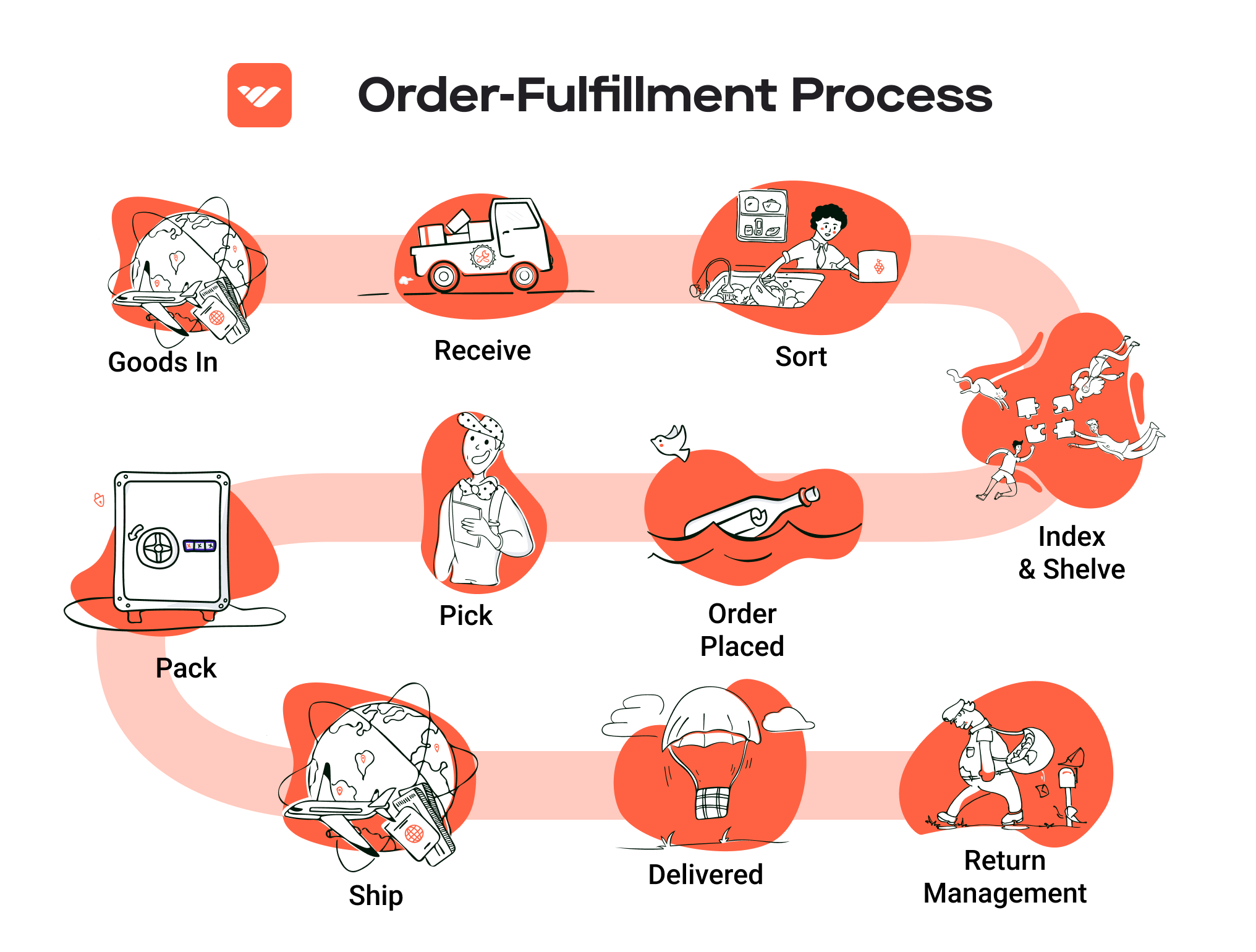
Dropshipping
Dropshipping is a fulfillment model where the retailer does not keep the products it sells in stock. Instead, when a retailer sells a product, it purchases the item from a third-party supplier who then ships it directly to the customer. This model is particularly well-suited for startups or businesses with limited capital, as it requires minimal upfront investment in inventory and infrastructure.
The primary advantage of dropshipping is the low financial risk. Retailers do not need to invest in inventory upfront, which allows them to offer a wide variety of products without the burden of excess stock. Additionally, dropshipping can provide flexibility in terms of product offerings and the ability to test new markets without significant financial commitments.
However, dropshipping also has notable drawbacks. Profit margins can be lower compared to in-house fulfillment or 3PL models, as suppliers typically charge higher prices for their services. Shipping times may also be longer, especially if products are sourced from international suppliers. This can lead to customer dissatisfaction if expectations for delivery are not met. Moreover, retailers have limited control over the fulfillment process, which can impact product quality and customer service. Thus, while dropshipping offers a low-risk entry point into e-commerce, businesses must be prepared to manage the complexities that come with relying on external suppliers for fulfillment.
In conclusion, choosing the right fulfillment model depends on your business stage, resources, and strategic goals. Each model has its unique advantages and challenges that can significantly impact operations and customer satisfaction.
A Deep Dive into Amazon FBA: Pros, Cons, and Who It’s For
Understanding Fulfillment by Amazon (FBA)
Fulfillment by Amazon (FBA) is a service that allows e-commerce businesses to utilize Amazon’s vast logistics network to store, pack, and ship products directly to customers. This service is a game-changer for many sellers, enabling them to leverage Amazon’s infrastructure and customer base while focusing on growing their business. Here’s how FBA works:
-
Product Storage: Sellers send their products to Amazon’s fulfillment centers, where they are stored until sold. These centers are strategically located across the country, ensuring efficient distribution.
-
Order Processing: When a customer places an order for a product listed as FBA, Amazon takes care of the entire process. This includes picking the product from the inventory, packing it, and shipping it directly to the customer.
-
Customer Service and Returns: Amazon handles customer service inquiries and returns for FBA products, allowing sellers to focus on other aspects of their business without the burden of logistics.
Pros of Fulfillment by Amazon
1. Prime Eligibility
One of the most significant advantages of using FBA is that products become eligible for Amazon Prime. This feature attracts millions of Prime members who are willing to pay more for faster shipping, significantly increasing sales potential.
2. Customer Trust
Amazon is a trusted name in e-commerce. By using FBA, sellers can enhance their credibility, as customers often perceive FBA products as more reliable due to Amazon’s stringent quality control and customer service standards.
3. Multi-Channel Fulfillment
FBA allows sellers to fulfill orders from other sales channels, such as eBay or their own website, using Amazon’s logistics. This integration streamlines operations and provides a cohesive fulfillment strategy.
4. Scalability
FBA can accommodate businesses of all sizes. As sales grow, sellers can easily scale operations without needing to invest in additional warehousing or logistics infrastructure.
5. Time Savings
By outsourcing logistics to Amazon, sellers can save significant time, which they can then invest in marketing, product development, or other critical business functions.
Cons of Fulfillment by Amazon
1. High Fees
While FBA offers numerous benefits, it comes with a price. Sellers are required to pay various fees, including storage fees for unsold inventory and fulfillment fees for each order. These costs can accumulate quickly, impacting overall profitability, especially for lower-priced items.
2. Strict Inventory Rules
Amazon enforces strict inventory management practices. Sellers must adhere to guidelines regarding how many units they can send to fulfillment centers, and failure to comply can result in penalties or removal from the FBA program.
3. Commingling Risks
FBA products may be commingled with those from other sellers, which can lead to issues with inventory tracking and quality control. If a customer receives a damaged or incorrect item, it reflects poorly on the seller, even if the issue originated from another seller’s inventory.
4. Loss of Control
Using FBA means relinquishing some control over the fulfillment process. Sellers depend on Amazon to handle customer service and returns, which can lead to dissatisfaction if the service does not meet their expectations.
5. Complexity of Returns
While Amazon handles returns, this can complicate inventory management for sellers. Returned items may not always be in sellable condition, which can lead to losses if not managed properly.
Who is FBA Best For?
Fulfillment by Amazon is an excellent option for certain types of sellers:
-
Small to Medium-Sized Businesses: Businesses looking to scale quickly can benefit from FBA’s infrastructure without the need for significant upfront investment in logistics.
-
Sellers with High Sales Volume: Those selling products with high turnover can find FBA particularly beneficial as it allows them to maximize sales potential while minimizing logistics hassles.
-
Brands Seeking Prime Eligibility: Sellers who want to tap into Amazon’s vast Prime customer base will find FBA indispensable for gaining visibility and increasing sales.
-
E-commerce Entrepreneurs: New entrepreneurs who prefer to focus on product sourcing and marketing rather than logistics may find FBA a perfect fit, allowing them to streamline operations.
-
Multi-Channel Sellers: Businesses that sell on multiple platforms can utilize FBA to fulfill orders from various channels, simplifying logistics management.
In conclusion, Fulfillment by Amazon offers a robust solution for e-commerce businesses looking to enhance their logistics capabilities and reach a broader audience. However, it is essential for sellers to weigh the pros and cons carefully, considering their specific business model and goals. By understanding how FBA fits into their overall strategy, entrepreneurs can make informed decisions that drive growth and efficiency in their operations.
Core Services Offered by Fulfillment Centers
Inventory Management & Warehousing
Inventory management is the backbone of any e-commerce operation, and fulfillment centers excel in providing sophisticated solutions for storing and tracking inventory. Fulfillment centers offer climate-controlled warehousing options to ensure that products are stored in optimal conditions, which is particularly crucial for sensitive items such as electronics or perishables.
The benefit of utilizing a fulfillment center for inventory management lies in their ability to offer real-time inventory tracking systems. These systems enable e-commerce businesses to gain insights into stock levels, monitor sales trends, and automate reordering processes. This reduces the risk of stockouts or overstocking, which can lead to lost sales or increased holding costs, respectively. Additionally, fulfillment centers often have advanced technology in place that integrates seamlessly with various e-commerce platforms, allowing businesses to manage their inventory efficiently across multiple sales channels.
Pick and Pack Services
Pick and pack services are critical components of the fulfillment process. This service involves the selection (picking) of products from the warehouse and preparing (packing) them for shipment to customers. Fulfillment centers employ trained staff and use sophisticated software to ensure accuracy in order fulfillment.
The primary benefit of pick and pack services is the speed and accuracy they bring to order processing. With the increasing consumer expectation for fast shipping, fulfillment centers can significantly reduce order processing times. This efficiency not only enhances customer satisfaction but also allows businesses to scale their operations without the need to invest heavily in additional labor or infrastructure. Furthermore, fulfillment centers often offer custom packaging options, which can help e-commerce brands enhance their branding and customer experience, setting them apart from competitors.
Kitting and Assembly
Kitting and assembly services refer to the process of combining individual items into ready-to-ship sets or kits. This can include anything from assembling a product that requires multiple components to packaging promotional items together for a special offer. Fulfillment centers that offer kitting services can streamline this process, allowing e-commerce businesses to deliver products that are ready for sale without the need for additional handling on their end.
The advantage of kitting and assembly services is that they allow businesses to offer bundled products, which can enhance sales opportunities and customer satisfaction. Bundled products often have higher perceived value, encouraging customers to purchase more. Additionally, by outsourcing kitting and assembly to a fulfillment center, businesses can focus their resources on core competencies such as marketing and product development, rather than on logistics.
Returns Management (Reverse Logistics)
Returns management, or reverse logistics, is an often-overlooked yet critical service provided by fulfillment centers. This involves the handling of returned products, including processing returns, restocking items, and managing exchanges. Efficient returns management is essential for maintaining customer satisfaction and loyalty, especially in an e-commerce landscape where easy returns are increasingly expected by consumers.
Fulfillment centers provide streamlined processes for managing returns, which can significantly reduce the time and resources e-commerce businesses spend on handling returns themselves. By leveraging a fulfillment center’s expertise in reverse logistics, businesses can ensure that returned products are processed quickly and accurately, allowing them to minimize losses and restock items for resale. Moreover, effective returns management can provide valuable insights into customer behavior and product performance, helping businesses to refine their offerings and improve overall customer experience.
Conclusion
Utilizing a fulfillment center offers a wide array of core services that can significantly enhance the efficiency and effectiveness of an e-commerce business. From inventory management and warehousing to pick and pack services, kitting and assembly, and returns management, these services provide critical support that allows businesses to focus on growth and customer satisfaction. As e-commerce continues to evolve, partnering with a proficient fulfillment center can be a strategic move for businesses looking to scale their operations successfully.
How to Choose a Fulfillment Partner: A 6-Point Checklist
Location & Warehouse Network
Importance: The geographical location of your fulfillment partner is crucial for optimizing shipping times and costs. A strategically placed warehouse network can significantly reduce delivery lead times, especially if your customer base is concentrated in specific regions. For businesses targeting the Southeast, having a partner with facilities in Jacksonville can be advantageous due to its logistical advantages and proximity to major shipping ports.
Questions to Ask:
– What are the locations of your warehouses, and how do they align with my target market?
– Can you provide details on your transportation network and delivery timelines?
– How do you handle order fulfillment for regions that may be further away from your warehouses?
Technology & Integrations
Importance: A fulfillment partner’s technology capabilities are essential for smooth operations. This includes inventory management systems, order processing software, and integration with e-commerce platforms. Efficient technology can streamline your operations, minimize errors, and provide real-time data on inventory levels and order status.
Questions to Ask:
– What technology platforms do you use for order management and inventory tracking?
– Can your system integrate with my existing e-commerce platform (e.g., Shopify, WooCommerce)?
– How do you handle data security and compliance with regulations (e.g., GDPR, CCPA)?
Specializations (e.g., cold storage, oversized items)
Importance: Depending on your product offerings, certain fulfillment centers may have specialized capabilities that are crucial for your business. For instance, if you sell perishable goods, ensure the partner can provide cold storage options. If your products are oversized or require special handling, confirm that the partner has the necessary equipment and expertise.
Questions to Ask:
– What specific types of products do you specialize in handling?
– Do you have facilities for temperature-sensitive items or oversized products?
– How do you manage quality control for specialized items during storage and shipping?
Scalability & Capacity
Importance: As your business grows, your fulfillment needs will evolve. Choosing a partner that can scale with you ensures that you won’t face bottlenecks as your order volume increases. A partner with adequate capacity will help you avoid delays and maintain customer satisfaction.
Questions to Ask:
– What is your current capacity for handling orders, and how do you plan to scale as my business grows?
– Have you managed rapid growth with other clients, and what strategies did you implement?
– How do you handle peak seasons or unexpected surges in order volume?
Pricing and Contracts
Importance: Understanding the pricing structure and contract terms of your fulfillment partner is vital for budgeting and financial planning. Transparent pricing prevents surprises down the line and helps you assess if the partner is a cost-effective choice for your business.
Questions to Ask:
– What is included in your pricing (e.g., storage fees, pick and pack fees, shipping costs)?
– Are there any additional costs I should be aware of (e.g., for returns, customer service)?
– What are the terms of the contract, and what is the process for termination or renegotiation?
Customer Support & Reviews
Importance: Excellent customer support can significantly impact your experience with a fulfillment partner. A responsive and knowledgeable support team can resolve issues quickly, ensuring that your operations run smoothly. Additionally, reviewing testimonials and case studies from other clients can provide insight into the partner’s reliability and service quality.
Questions to Ask:
– What levels of customer support do you offer, and what are your response times?
– Can you provide references or case studies from similar businesses you’ve worked with?
– How do you handle disputes or issues that may arise during the fulfillment process?
Conclusion
Choosing the right fulfillment partner is a critical decision that can influence the success of your e-commerce business. By using this checklist, you can ensure that you evaluate potential partners thoroughly, focusing on the aspects that matter most for your specific needs. A well-chosen fulfillment partner can enhance your operational efficiency, improve customer satisfaction, and ultimately contribute to your business growth.
Understanding Fulfillment Pricing: A Breakdown of Common Fees
Initial Setup Fees
When partnering with a fulfillment center, businesses often encounter initial setup fees. These are one-time charges that cover the costs associated with onboarding your account, which may include the integration of your systems with the fulfillment center’s software, training, and any initial inventory setup. The specifics of these fees can vary widely based on the complexity of your operations and the technology stack involved.
Typically, setup fees can range from a few hundred to several thousand dollars, depending on the fulfillment provider’s services. To calculate this fee, providers may assess the number of SKUs, the integration level required, and any customized solutions you might need. It’s essential to discuss these fees upfront to avoid unexpected costs later on.
Receiving Fees
Receiving fees are charged for the process of unloading and inspecting incoming inventory. This includes the labor and equipment needed to handle your products as they arrive at the fulfillment center. The receiving fee is usually calculated per pallet or per shipment and may also factor in the complexity of the items being received.
For example, if your products require special handling or inspection, the receiving fee may be higher. It’s common for fulfillment centers to charge between $20 to $50 per pallet, but this can vary based on the provider’s location and operational capabilities. Understanding this fee is crucial, especially if you have a high volume of incoming inventory.
Storage Fees (per pallet/bin)
Storage fees are recurring charges for keeping your inventory in the fulfillment center. These are typically calculated on a monthly basis and can be expressed as a cost per pallet or per cubic foot. The pricing structure can vary depending on the fulfillment center’s location and the type of goods stored.
For example, a typical range for storage fees might be between $15 to $30 per pallet per month. However, if your products are large or bulky, they may take up more space and thus incur higher storage fees. Additionally, some providers may charge for bin storage, which is often on a per-bin basis. It’s important to evaluate your inventory turnover rate when considering storage fees, as slow-moving products can lead to higher costs over time.
Pick & Pack Fees (per item/order)
Pick and pack fees cover the process of selecting items from storage and preparing them for shipment. This fee is typically charged per item or per order and can vary based on the complexity of the order. For instance, an order that includes multiple items or requires special packaging may incur higher fees.
On average, pick and pack fees can range from $1 to $5 per item, with discounts often available for larger orders. Fulfillment centers might also offer tiered pricing, where the cost per item decreases as order volume increases. Understanding the pick and pack process is vital, as it directly impacts your operational efficiency and customer satisfaction.
Shipping Fees
Shipping fees are one of the most significant costs associated with fulfillment. These fees are calculated based on several factors, including the weight and dimensions of the packages, the shipping method selected, and the destination of the shipment. Fulfillment centers often have negotiated rates with carriers, which can lead to savings for businesses.
Typically, shipping fees can be categorized into standard, expedited, and international rates, with costs varying significantly between these categories. It’s crucial to work with your fulfillment partner to understand how they calculate shipping fees, as these can directly impact your pricing strategy and customer experience.
Tips for Getting an Accurate Quote
-
Be Transparent About Your Needs: Provide detailed information about your products, order volume, and expected growth. This helps fulfillment centers offer tailored solutions.
-
Ask for a Breakdown of Fees: Request a comprehensive list of all potential fees associated with your account. This should include initial setup fees, receiving fees, storage fees, pick and pack fees, and shipping fees.
-
Consider Your Inventory Turnover Rate: Discuss how often you plan to move inventory, as this can significantly affect storage and pick and pack fees.
-
Evaluate Additional Services: Inquire about any extra services that may incur additional costs, such as returns processing, custom packaging, or kitting.
-
Negotiate Rates: Don’t hesitate to negotiate fees, especially if you anticipate high volumes or long-term partnerships. Fulfillment centers may offer discounts for larger commitments.
By understanding these common fulfillment pricing models and actively engaging with your fulfillment partner, you can ensure that you are making informed decisions that align with your business goals and budget.
Frequently Asked Questions (FAQs) about Fulfillment
1. What is Amazon Fulfillment in Jacksonville?
Amazon Fulfillment in Jacksonville refers to the network of fulfillment centers operated by Amazon in the region, specifically designed to store, pack, and ship products efficiently to customers throughout the Southeast. These facilities play a crucial role in Amazon’s logistics strategy, ensuring timely delivery and enhanced customer satisfaction.
2. How does Amazon Fulfillment differ from a traditional warehouse?
A fulfillment center, like those operated by Amazon, focuses on the entire order fulfillment process, which includes inventory management, order processing, packing, and shipping. In contrast, a traditional warehouse primarily serves as a storage space for goods without the added services of order handling and distribution.
3. What benefits does Jacksonville offer for fulfillment services?
Jacksonville provides several advantages for fulfillment services, including its strategic location as a gateway to Florida, access to multiple deep-water ports, and a growing population that increases demand for e-commerce. These factors contribute to shorter delivery times and a robust logistics infrastructure.
4. What is a 3PL (Third-Party Logistics) provider?
A 3PL is a company that provides outsourced logistics services, which can include transportation, warehousing, and fulfillment. Businesses often partner with 3PLs to enhance their supply chain efficiency without the need to manage logistics operations internally.
5. How much do fulfillment services cost in Jacksonville?
The cost of fulfillment services can vary widely based on factors such as order volume, storage needs, and specific service requirements. Generally, fulfillment costs include storage fees, picking and packing fees, shipping costs, and any additional services provided. It is advisable to request quotes from multiple providers to find the best fit for your business.
6. What types of products can be fulfilled through Amazon’s Jacksonville centers?
Amazon’s fulfillment centers in Jacksonville can handle a wide range of products, from electronics and apparel to household goods and more. However, certain restrictions may apply to hazardous materials or perishable items, so it’s essential to check with Amazon for specific guidelines.
7. How do I get started with Amazon Fulfillment in Jacksonville?
To start using Amazon Fulfillment, you need to create an Amazon seller account, list your products, and enroll in the Fulfillment by Amazon (FBA) program. From there, you can ship your products to the Jacksonville fulfillment centers, and Amazon will handle storage, packing, and shipping to your customers.
8. What is the process for returns in Amazon Fulfillment?
Amazon has a streamlined returns process for products sold through its platform. Customers can initiate returns via their Amazon account, and the fulfillment center will handle the return logistics, including restocking items and updating inventory levels.
9. Can I track my inventory in Amazon’s fulfillment centers?
Yes, Amazon provides sellers with real-time inventory tracking tools through their seller dashboard. This allows you to monitor stock levels, sales velocity, and inventory health, helping you make informed decisions about restocking and product management.
10. What should I consider when choosing a fulfillment center in Jacksonville?
When selecting a fulfillment center, consider factors such as location, shipping capabilities, technology integration, service offerings, pricing structure, and customer service. It’s important to choose a partner that aligns with your business needs and can scale as your operations grow.
Conclusion: Is Outsourcing Fulfillment the Right Move for Your Business?
Key Benefits of Using a Fulfillment Service
Outsourcing fulfillment can be a game changer for e-commerce businesses looking to scale operations efficiently. By partnering with a third-party logistics (3PL) provider, businesses can save significant time and resources that would otherwise be spent managing warehousing, packing, and shipping. This allows you to focus on core activities such as product development and marketing, ultimately driving growth.
Moreover, fulfillment services offer unparalleled scalability. As your business grows, a proficient fulfillment partner can seamlessly adapt to fluctuating order volumes without the need for heavy investments in infrastructure or labor. This flexibility ensures that you can meet customer demands without compromising service quality, which is crucial in today’s fast-paced market.
Expertise is another compelling advantage. Fulfillment centers, particularly those with established networks like those in Jacksonville, bring years of experience and knowledge to the table. They are equipped to handle logistics complexities, including international shipping regulations, which can be daunting for small to medium-sized enterprises. Their insights can lead to improved efficiency, reduced shipping costs, and enhanced customer satisfaction.
Choosing the Right Partner for Growth
However, the effectiveness of outsourcing fulfillment largely depends on selecting the right partner. Not every 3PL is suited for every business model, and factors such as location, cost structure, and service offerings must align with your specific needs. Conduct thorough due diligence, assess potential partners’ capabilities, and ensure they can support your long-term growth strategy.
Call to Action
To determine if outsourcing fulfillment is the right move for your business, consider conducting an audit of your current shipping and logistics processes. Identify areas where you are facing challenges, such as high costs or slow delivery times. This assessment will provide valuable insights and help you make informed decisions about whether to engage a fulfillment partner. Remember, the right choice can propel your business to new heights, optimizing both efficiency and customer satisfaction.
Important Disclaimer
⚠️ Important Disclaimer
The information in this guide is for educational purposes. Fulfillment services, pricing, and platform features change frequently. Always conduct your own due diligence and consult with providers directly before making business decisions.
